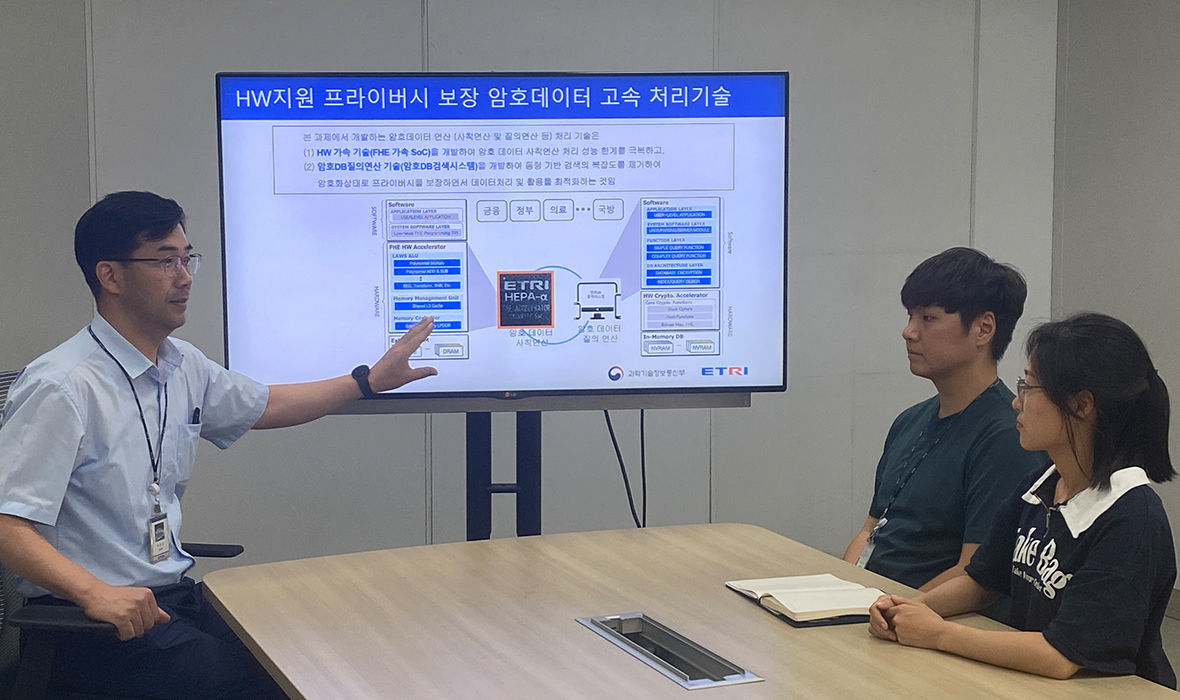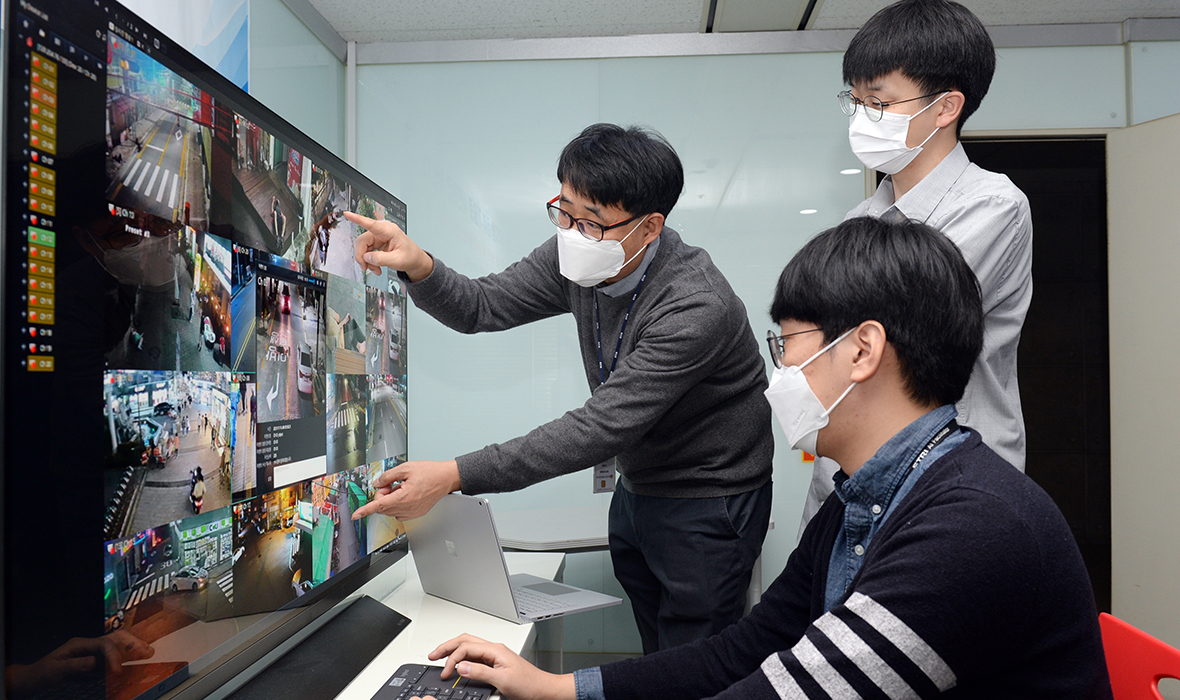
News
Vol.74
NEWS 1
ETRI Achieves a Breakthrough in Core Technology for Thin and Flexible Solid-State Batteries
- Monocell battery energy density increased by 6 times and thickness reduced by more than 10 times compared to conventional methods
- Successful development of a film-type solid-state electrolyte membrane using polymer fabric support
※ Materials & Components Research Division, Smart Materials Research Section

Electronics and Telecommunications Research Institute(ETRI) has announced a significant breakthrough in solid-state battery technology. They have successfully developed a solid-state electrolyte membrane using sulfide-based solid electrolytes and polymer fabric support, resulting in solid electrolyte membranes that are more than 10 times thinner and exhibit a 6-fold increase in energy density compared to conventional solid electrolyte pellets*. This accomplishment has been published in the prestigious international academic journal “ACS Applied Materials & Interfaces” confirming its excellence.
Solid-state batteries represent a fundamental shift in battery technology as they replace liquid electrolytes with solid materials. This substitution of flammable liquid electrolytes with solid electrolytes inherently reduces the risk of leakage or fire. In previous research on solid-state batteries, the conventional approach involved applying pressure to solid electrolyte particles or utilizing a sintering** process, where powders are heated to a temperature below their melting point, causing them to fuse and form pellets with thicknesses in the range of several micrometers(μm)***.
However, solid electrolyte pellets were susceptible to breakage, making it challenging to impart flexibility to battery cells using them. Furthermore, their increased thickness inadvertently resulted in lower energy density in the cells, contrary to expectations, posing a hurdle to commercialization.
To overcome these limitations, ETRI researchers have successfully developed thin solid electrolyte membranes using sulfide-based solid electrolyte with excellent ionic conductivity and a mechanically robust polymer fabric support. Additionally, they have developed a wet fabrication technology that facilitates large-scale production while ensuring outstanding performance, mechanical strength, and flexibility. Compared to conventional pellet-shaped solid electrolytes, the solid electrolyte membrane developed by the ETRI research team is more than 10 times thinner and exhibits a 2-fold increase in ionic conductivity. Consequently, the output characteristics of monocells*** employing ETRI’s solid electrolyte membrane have improved by 20%, and the energy density per unit volume has increased by a remarkable 6-fold compared to existing solutions.
Furthermore, comprehensive testing, including high-temperature exposure and high-voltage testing, has empirically confirmed the outstanding stability of ETRI’s solid-state batteries. ETRI anticipates leading the commercialization of next-generation solid-state batteries with high capacity and versatile form factors.
* Pellet: A small, densely compacted piece of material formed by compressing solid particles.
** Sintering: A thermal treatment process that involves heating powdered or granulated materials to a temperature below their melting point, causing them to melt and bond to each other.
*** μm(Micrometer): A unit of measurement equal to one millionth of a meter.
**** Monocell: The smallest unit of a battery comprising the cathode, anode, electrolyte, and separator.
Lee Young-gi, Director
Smart Materials Research Section
(+82-42-860-6822, lyg@etri.re.kr)
NEWS 2
ETRI Secures High-Speed Homomorphic Encryption Chip Technology
- Attaining Breakthroughs in Cryptographic Replacement Technology, Significantly Enhancing Homomorphic Encryption Computation Speed
- Ensuring Decryption-Free Operations and Security, Applicable Across Defense, Public, Medical, Financial, and Industrial Sectors
※ Sudogwon Research Center, Security SoC Convergence Research Section

ETRI has successfully developed an accelerator chip for Fully Homomorphic Encryption(FHE)*, which ensures privacy while allowing for applications such as machine learning and the ability to withstand quantum computer hacking. FHE is an encryption method that enables computations on encrypted data, where the results of operations on plaintext and the results of operations on each ciphertext yield the same value. This achievement marks a significant advancement in secure data processing and encryption technology.
The research team envisions that this technology, once commercialized, can be integrated into cloud data center servers and used in artificial intelligence semiconductors(SoC) that ensure personal data protection.
The development of this technology is expected to boost research related to dedicated chips and software development platforms for homomorphic encryption accelerators in the future. This advancement is poised to enable the direct application of encrypted data to various integrated services in sectors such as defense, public, medical, financial, and industrial domains, where both security and statistical and artificial intelligence applications are simultaneously required.
Fully Homomorphic Encryption technology offers the advantage of processing encrypted data without the need for additional decryption or re-identification** steps. It is hailed as the next-generation encryption technology, exhibiting resistance to cryptographic breaches even in quantum computing environments, thereby providing robust security.
Traditional encryption technologies faced limitations in directly performing operations on encrypted data. They required the use of a secret key to decrypt the data back into its original form, followed by re-encryption before transmission. In this process, there were inherent constraints where both the secret key and the original information could potentially be exposed. Consequently, it was unsuitable for computational processing of data containing sensitive information.
The core technology of the Fully Homomorphic Encryption hardware accelerator chip developed by ETRI is a dedicated hardware processing device designed to align with the unique characteristics of homomorphic encryption. In homomorphic encryption, when data is encrypted, it is represented as polynomials with coefficients in the thousands of bits or even higher, a distinctive feature of this encryption method.
As a result, this specialized hardware processor is capable of swiftly performing operations such as addition, subtraction, multiplication, and division among high-degree polynomials, which represent encrypted data. This principle allows for the direct computation of encrypted data, with only the results being decrypted for viewing. Nobody can access the original data, ensuring robust data privacy. The research team intends to utilize this core chip technology as a foundation for implementing dedicated System-on-Chip(SoC) solutions for homomorphic encryption in the future, aiming to make it practical and commercially viable.
* Fully Homomorphic Encryption(HE): An encryption method that allows data to be operated on while in an encrypted state. It ensures that the result of performing operations on plaintext and the result of performing operations on each ciphertext are the same.
** Decryption: The process of converting ciphertext into plaintext.
Park Seong-cheon, Director
Security SoC Research Convergence Section
(+82-31-739-7270, scpark@etri.re.kr)
NEWS 3
ETRI Unveils Next-Generation Core Technologies at IFA in Germany
- Showcases 5 Technologies, including FlenOptic Microscope, DeepView, and B5G Optical Access
- Releases Leading-Edge Next-Generation Core Technologies, Aiming for Global Technology Commercialization
※ External Relations Department, Public Relations Section

Korean researchers participated in the world’s largest consumer electronics exhibition, the IFA(Internationale Funkausstellung) held in Berlin, Germany, and unveiled their research achievements in artificial intelligence(AI), communication, and media. During this exhibition, the researchers showcased five technologies, including a plenoptic microscope, a deep-view visual intelligence platform, B5G optical access, video feature extraction and detection for preventing illegal content distribution, and multi-user remote immersive extended reality(XR) technology.
The first technology is the Plenoptic Microscopy technology, which is inspired by the compound eye structure of insects. This technology involves attaching a ‘Micro Lens Array(MLA)’* to a camera, which manipulates the path of light through micro lenses to enhance light extraction efficiency. It combines multiple 2D images captured from different angles to create a 3D image. Plenoptic Microscopy technology can be applied in various fields, including skin tissue examination and defect diagnosis in semiconductor manufacturing processes.
The second technology is the DeepView Visual Intelligence Platform. This technology is based on visual artificial intelligence and involves in-depth analysis of large-scale images and videos to extract and provide information tailored to user requirements. It is a cutting-edge platform for visual analysis that can be utilized to address various societal issues, ranging from preventing urban safety incidents to enforcing regulations against illegal dumping of waste. As a result, it has garnered attention in the emerging field of smart city industries, positioning itself as a technology for the future.
The third technology is B5G(Beyond 5G)** Optical Access.*** B5G refers to moving beyond the commercialization of the world’s first 5th generation(5G) mobile communication and expanding the use of 5G convergence services in various industrial sectors. The B5G Optical Access technology involves connecting segments within a 20km range with optical fibers between service providers and subscribers, enabling the provision of both wired and wireless services through optical network technology. This technology is essential for seamless access to future services such as virtual reality, metaverse, and industrial internet from anywhere and at any time, thanks to its wide bandwidth and ultra-low latency mobile fronthaul**** and backhaul***** capabilities, which link digital data processing devices in wireless access networks and connect peripheral networks to the core network through multiple communication networks, respectively.
Next is the technology for extracting and detecting video features to combat the distribution of illegal content. This technology is designed to create unique characteristic values for videos distributed online, allowing for the comparison and identification of whether the content is illegal or not. It serves as a crucial tool for blocking the distribution of illegal content online.
Lastly, they presented the Multi-Participant Remote Immersive Extended Reality(XR) technology. Immersive XR technology is an innovative concept that allows users to experience both Augmented Reality(AR) and Virtual Reality(VR) within a single content. Using integrated displays, AR users can manipulate their characters with hand gestures, while remote users in VR environments can interact with synchronized character movements through real-time motion recognition. This enables users to share the content and experience a sense of presence as if they were on-site.
* Micro Lens Array(MLA): A technology that uses micro lenses to manipulate the path of light, increasing light extraction efficiency.
** Beyond 5G(B5G): Refers to the expansion of 5G technology beyond its commercialization phase to enable its use in various industries.
*** Optical Access: A network technology that connects segments within a 20km range using optical fibers to provide both wired and wireless services between service providers and subscribers.
**** Fronthaul: A link that connects digital data processing devices in the wireless access network with remote wireless signal processing devices in mobile communication’s wireless access network.
***** Backhaul: A link that connects peripheral networks in a hierarchical communication network that transmits data through multiple communication networks to the core network, connecting them to the metropolitan network or the internet.
Kil Ho Chong, Director
Public Relations Section
(+82-42-860-0670, khchong@etri.re.kr)